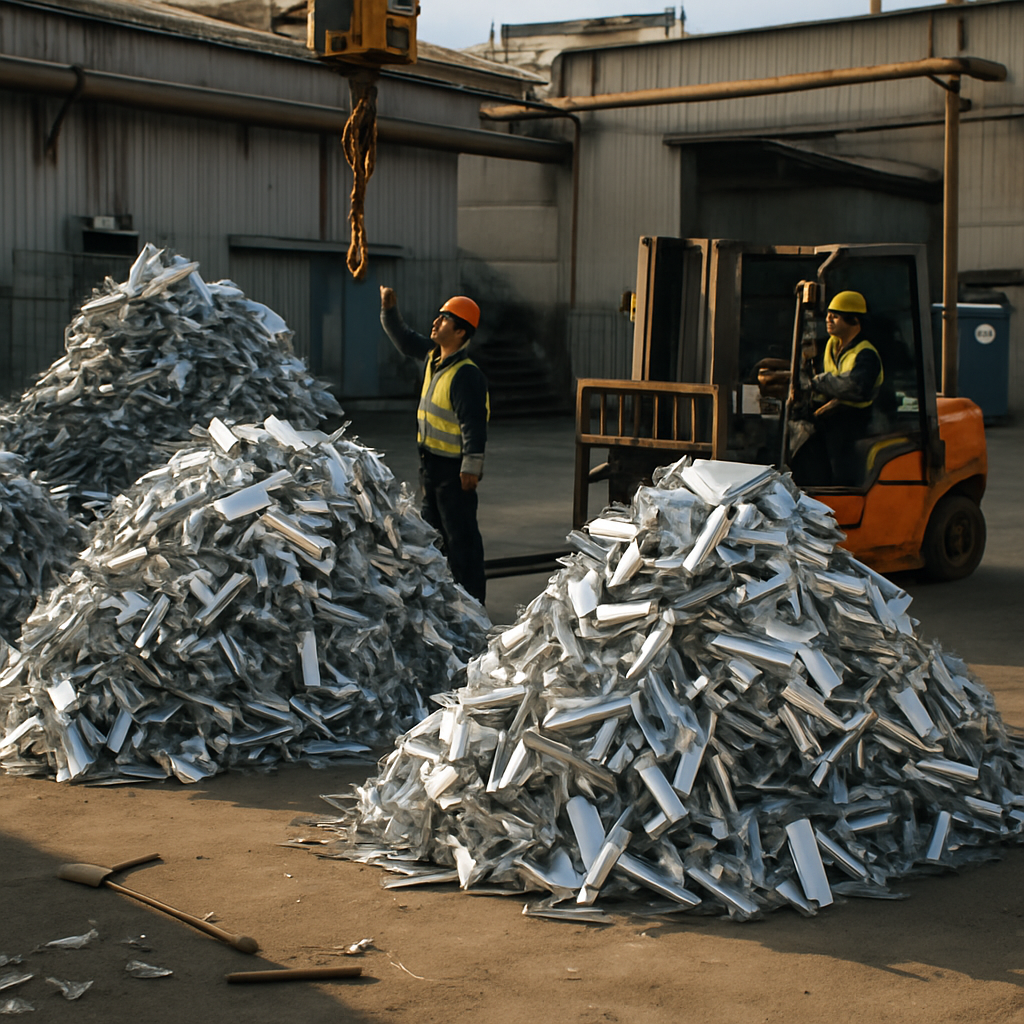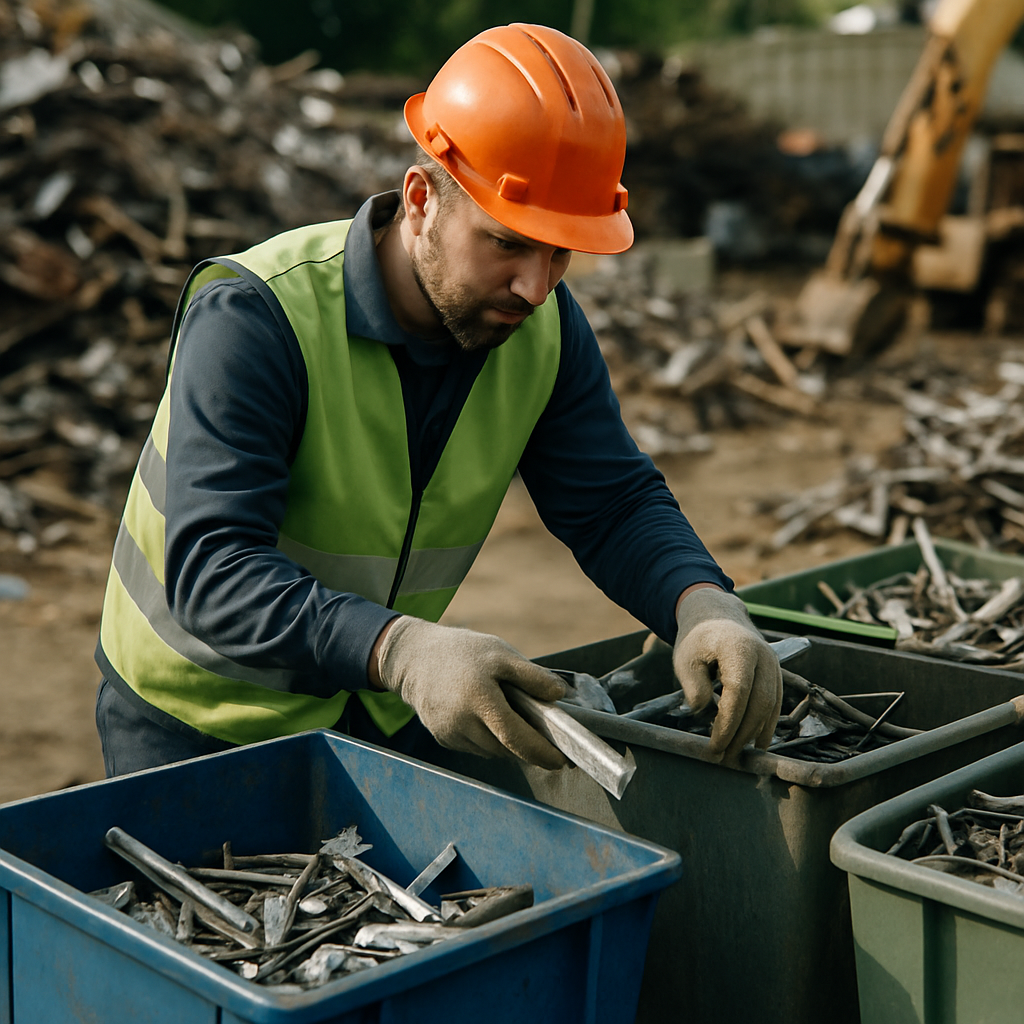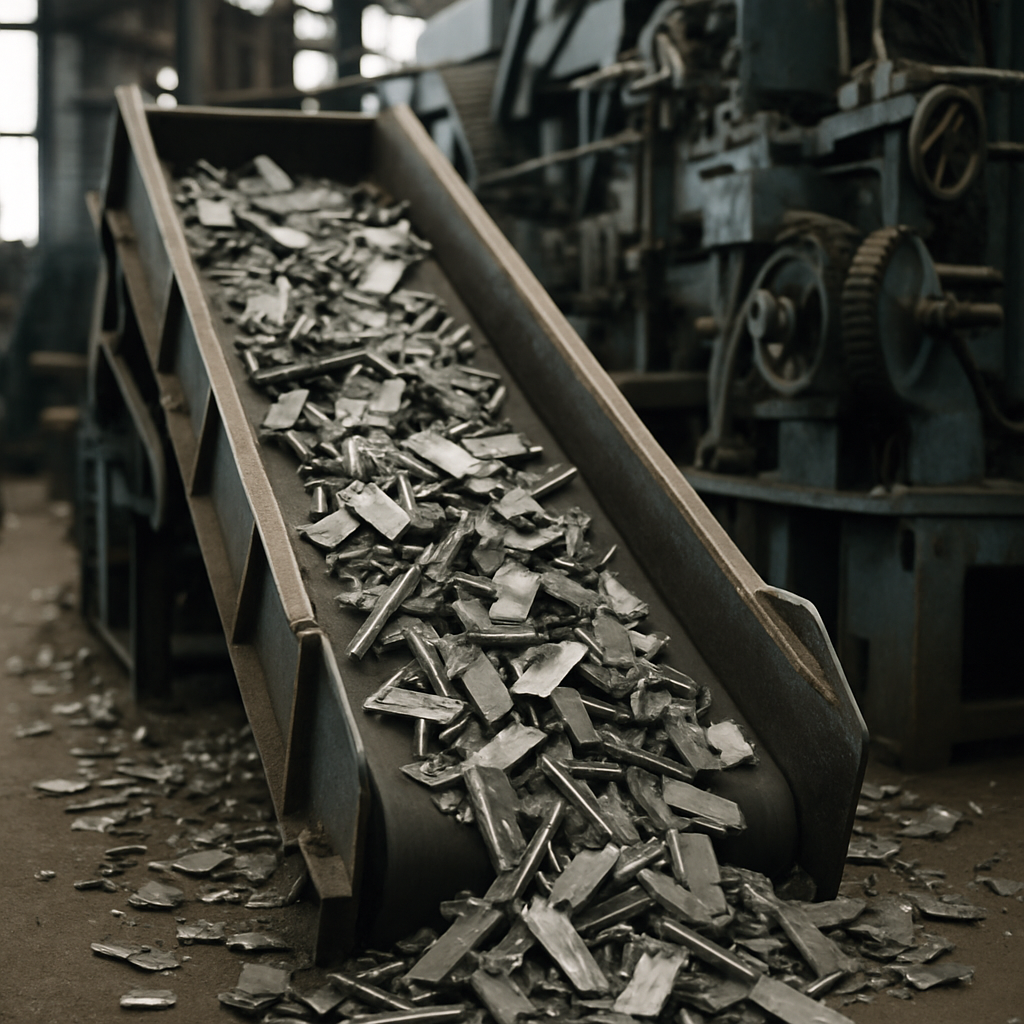5901 Botham Jean Blvd, Dallas, TX 75215
Metal Scrap Collection: Methods, Benefits & Recycling Process
September 19, 2025Metal scrap collection involves the systematic gathering of discarded metal materials from various sources for recycling purposes. Each year, millions of tons of metal that could end up in landfills are collected and repurposed through this process.
The collection process targets materials from residential neighborhoods, commercial establishments, and industrial facilities. This includes household appliances, beverage cans, construction debris, and manufacturing byproducts. Collection methods vary based on the volume and type of metal, ranging from curbside pickup programs to industrial-scale container services.
This initial gathering stage is the vital first step in the metal recycling chain. Without effective collection systems, valuable metals would be lost to landfills instead of being reprocessed into new products. The environmental benefits are significant—metal scrap collection helps conserve natural resources, reduces energy consumption, and minimizes the environmental impact associated with mining and processing raw materials.
How is Metal Scrap Collected?

Collection Methods for Individuals
Curbside recycling programs provide an easy option for homeowners to recycle metal scrap. These municipal services typically accept aluminum cans, steel food containers, and small metal items. Place these materials in designated recycling bins on your regular collection day.
Drop-off centers offer another option for larger metal items. These facilities accept a broader range of materials than curbside programs and often sort metals by type, allowing for more efficient processing and higher recovery rates.
Scrap yards directly purchase metals from individuals, offering payment based on weight and material type. This option suits those with substantial quantities or valuable metals like copper and brass.
Business Collection Solutions
Businesses usually generate larger scrap metal volumes and need different collection strategies. Many companies establish ongoing relationships with scrap yards for regular pickup services, which reduce transportation costs and ensure consistent material management.
Industrial facilities often employ specialized containers designed for specific metal types to prevent contamination and protect materials from weather exposure. Some recycling partners include these containers in their service packages.
Construction and demolition projects produce significant metal waste. These operations typically use roll-off containers for efficient collection and transportation of structural steel, pipes, and other building materials.
Environmental Standards in Collection
The collection process adheres to strict environmental guidelines to prevent contamination and ensure worker safety. Regulations from the Environmental Protection Agency specify how certain metals must be handled, particularly those with hazardous components.
Proper sorting is essential to efficient collection. Separating ferrous metals (containing iron) from non-ferrous metals (like aluminum and copper) enhances recycling efficiency. Many facilities use magnetic separation and other technologies for this purpose.
The transportation of collected scrap must comply with environmental standards to avoid spillage or contamination during transit. Vehicles and containers specifically designed for metal transport reduce these risks.
Specialized Collection Methods
Some high-value metals need specific collection methods. Catalytic converters, which contain precious metals, require proper documentation during collection to prevent theft and ensure legal compliance.
Electronics recycling programs recover valuable metals like gold, silver, and copper from devices. These programs often provide secure destruction services for sensitive data while recovering metal components.
Automotive recycling is a significant source of metal scrap collection. Vehicles contain numerous metal types, from aluminum engine components to steel body panels. Specialized auto recyclers dismantle vehicles to efficiently separate these materials.
| Collection Method | Target Audience | Examples of Scrap Collected |
| Curbside Recycling | Individual | Aluminum cans, steel food containers, small metal items |
| Drop-off Centers | Individual | Larger metal items |
| Scrap Yards | Individual | Substantial quantities of metals like copper and brass |
| Regular Pickup Services | Business | Large volumes of scrap metal |
| Specialized Containers | Industrial Facilities | Specific metal types |
| Roll-off Containers | Construction Projects | Structural steel, pipes |
What Happens After Metal Scrap is Collected?

Once metal scrap arrives at recycling facilities, it embarks on a meticulous transformation journey from waste to valuable resource. This process is designed to maximize material recovery while minimizing environmental impact.
Sorting: Separating Metals by Type
The initial step involves sorting metals into distinct categories. Workers and automated systems separate ferrous metals (containing iron) from non-ferrous metals using magnetic separation technology.
Ferrous metals like steel and iron respond to magnets, making them easy to identify. These materials represent the largest recycling activity globally, with over 80 million tons processed annually in North America alone.
Non-ferrous metals such as aluminum, copper, and brass don’t stick to magnets and typically hold higher value per pound due to their unique properties. Advanced sorting technologies, including infrared scanning and x-ray systems, help identify these materials with precision.
Cleaning and Preparation
Before processing can begin, contaminants must be removed from the scrap metal. This cleaning phase eliminates non-metallic materials, coatings, and other impurities that could compromise quality. Recycling facilities use various techniques to strip plastic from wires, remove paint, and separate metal components from composite items.
Clean metal produces higher quality end products and requires less energy during later processing stages, enhancing the overall recycling chain.
Shredding and Size Reduction
The metal then enters powerful shredders and hydraulic machines that cut and compress it into smaller pieces. This step serves multiple purposes: it reduces volume for easier transportation, creates uniform pieces for consistent processing, and increases surface area for more efficient melting.
Modern shredding systems can process tons of material hourly, transforming bulky scrap into manageable fragments. The shredded metal then moves along conveyor systems to the next processing stage.
Melting: Transformation Begins
Shredded metal is fed into large, specialized furnaces calibrated to the specific metal type. Different metals require various temperature settings due to their unique melting points and properties.
For steel recycling, electric arc furnaces (EAFs) provide environmental advantages. EAF technology uses electricity to melt metal scrap rather than raw ore, reducing greenhouse gas emissions by roughly two-thirds compared to traditional blast furnaces.
The melting process can take minutes to hours depending on volume, metal type, and furnace capacity. Although energy-intensive, recycling metal uses significantly less energy than creating new metal from raw materials.
Purification: Ensuring Quality
In liquid form, the metal undergoes purification to remove any remaining impurities. A common method is electrolysis, where an electric current passes through the molten metal. Pure metal deposits at the cathode while impurities settle as residue.
This step ensures that recycled metal meets quality standards for manufacturing applications. The cleaner the metal, the more versatile its potential uses in new products.
Solidification and Manufacturing Preparation
After purification, the molten metal travels via conveyor to cooling chambers where it solidifies into standardized forms. Common outputs include sheets, blocks, and bars that serve as manufacturing inputs.
These solidified forms make transportation and handling more efficient while providing manufacturers with consistent raw materials. The metal has now completed its transformation from scrap to valuable manufacturing resource.
Once solidified, these recycled metal forms are shipped to manufacturers who will transform them into new products, beginning the material lifecycle anew. One ton of recycled steel conserves 2,500 pounds of iron ore, 1,400 pounds of coal, and 120 pounds of limestone that would otherwise be mined.
This closed-loop system exemplifies the circular economy in action. Steel can be recycled repeatedly without quality loss, making metal recycling one of our most sustainable material management practices.
Why is Metal Scrap Collection Important?

Metal scrap collection is vital for conserving resources in our resource-conscious world. The planet has a finite amount of metal resources. Without recycling, these materials would deplete through continued extraction and use. By collecting and recycling scrap metal, we preserve these resources and significantly reduce the demand for new mining operations.
The environmental benefits extend beyond resource conservation. Metal production from raw ore requires substantial energy and creates significant greenhouse gas emissions. Recycling aluminum, for instance, saves up to 95% of the energy needed to produce it from raw materials, preventing approximately 29 million tons of CO2 emissions annually—equivalent to removing 6.3 million cars from roads.
Metal scrap collection also brings substantial economic advantages. The recycling industry generates nearly $18 billion in export sales annually while creating employment opportunities throughout the supply chain. Recycling facilities employ over 470,000 workers directly in the United States alone, and indirect employment exceeds one million positions. Recycling creates six times more jobs than landfilling materials.
Reducing landfill waste is another critical benefit. Metals contain toxic chemicals like mercury and lead, which pose environmental hazards when improperly disposed of in landfills. These substances can contaminate soil and water, endangering both humans and wildlife. Recycling diverts potentially harmful materials from waste streams and prevents them from leaching into ecosystems.
For businesses and individuals, financial incentives make metal recycling attractive. Companies can recoup costs by selling unused metal materials rather than paying disposal fees. Meanwhile, individuals can receive payment for bringing valuable metals to recycling centers, creating a win-win situation where environmental protection aligns with economic benefit.
The circular economy benefits tremendously from metal scrap collection. Approximately 70% of recycled metal commodities processed in the U.S. return to consumers as new products. This closed-loop system reduces manufacturing costs, potentially lowering prices for consumers while maintaining product quality and performance.
| Benefit | Description |
|---|---|
| Energy Conservation | Recycling aluminum saves up to 95% of the energy needed compared to production from raw materials; steel recycling saves about 60% energy. |
| Resource Conservation | Recycling one ton of steel conserves 2,500 pounds of iron ore, 1,400 pounds of coal, and 120 pounds of limestone. |
| Economic Activity | The recycling industry contributes over $100 billion annually to the U.S. economy and supports around 500,000 jobs. |
| Greenhouse Gas Reduction | Recycling can reduce greenhouse gas emissions by up to 95% for aluminum and 86% for steel, significantly mitigating climate change. |
| Water Conservation | Recycling reduces water use by up to 90% for some metals, providing critical savings in water-scarce regions. |
Despite these advantages, current recycling rates are below 40% of total metal waste. This represents a significant opportunity to expand collection efforts and maximize the environmental and economic benefits of metal recycling. As awareness grows about the importance of metal scrap collection, more individuals and businesses can engage in this crucial sustainability practice.
Conclusion: The Future of Metal Scrap Collection

The metal scrap collection industry is at a crucial point in our environmental journey. As sustainability initiatives gain global momentum, recycled metals are becoming increasingly critical to the manufacturing, construction, and technology sectors. Innovations in AI-powered sorting systems, automated processing, and blockchain-based supply chain tracking are transforming how we collect and process metal scrap. These advancements not only improve efficiency but also make recycling more economically viable for businesses of all sizes.
For a truly sustainable future, we must embrace a circular economy model where metal resources remain in use for as long as possible. By participating in metal scrap collection efforts, individuals and businesses can contribute meaningfully to conserving natural resources, reducing energy consumption, and minimizing greenhouse gas emissions. Recycling aluminum, for instance, saves up to 95% of the energy required to produce it from raw bauxite ore. These environmental benefits multiply with each recycling cycle.
Ready to support this sustainable vision and ensure your metal waste becomes part of the circular economy? Contact Okon Recycling at 214-717-4083 for professional guidance on your metal scrap collection and recycling needs.
